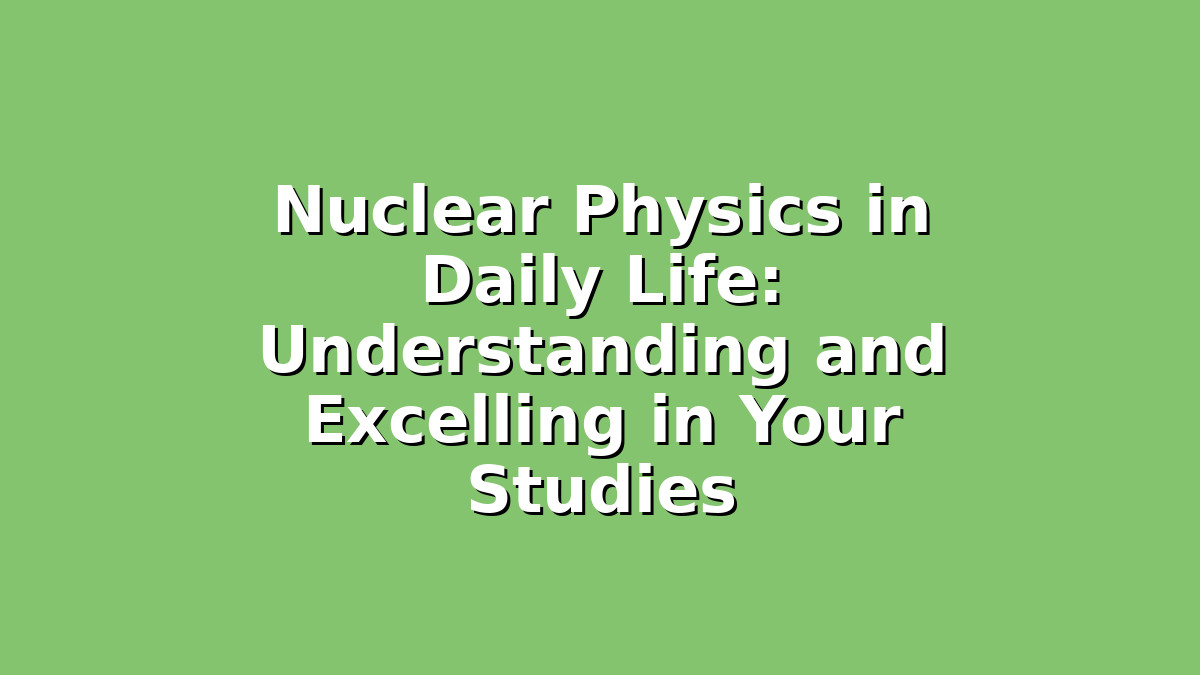Nuclear physics might sound like a complex and distant field reserved for scientists in laboratories, but in reality, it plays a significant role in our everyday lives. For students preparing for exams, especially in science subjects, understanding how nuclear physics connects to the world around us can make the topic more interesting and easier to grasp. This article will explore how nuclear physics impacts daily life, provide practical study tips to help you master the subject, and encourage you to approach your preparation with confidence and curiosity.
Introduction: Why Study Nuclear Physics?
At first glance, nuclear physics might seem abstract or challenging because it deals with the tiny particles inside atoms and the powerful forces at work. However, its applications are visible everywhere—from the energy that powers our homes to medical treatments and even the glow of your smoke detector. Grasping these real-world connections can help you remember key concepts and stay motivated during your study sessions. Moreover, nuclear physics often appears in exams as a critical topic, so building a strong foundation is essential for success.
—
1. Nuclear Physics and Energy: Study Tips for Understanding Concepts
One of the most practical applications of nuclear physics is nuclear energy, which comes from splitting or combining atomic nuclei. This process releases a tremendous amount of energy, used in nuclear power plants to generate electricity. When studying this topic, focus on the following key concepts: nuclear fission, nuclear fusion, radioactive decay, and half-life.
#### How to Study This Section Effectively:
– Use Visual Aids: Diagrams of nuclear reactions can help you understand how atoms change during fission and fusion. Drawing these yourself reinforces memory.
– Relate to Real Life: Think about how nuclear power plants work or how the Sun produces energy through fusion. Linking theory to everyday examples deepens comprehension.
– Practice Numerical Problems: Many exam questions involve calculating half-life or energy released during reactions. Regular practice with formulas helps build confidence.
Remember, understanding the source of nuclear energy is not just about memorizing facts but appreciating how these reactions power cities and contribute to sustainable energy solutions in the future.
—
2. Nuclear Physics in Medicine: Techniques and Exam Preparation Strategies
Did you know that nuclear physics is vital in healthcare? Medical technologies like X-rays, PET scans, and radiation therapy use nuclear physics principles to diagnose and treat diseases. Radioactive isotopes help doctors see inside the body or target cancer cells.
#### Study Strategies to Master This Section:
– Connect Theory to Applications: When you learn about radioactive decay or half-life, think about how isotopes are chosen based on their decay rates for medical use.
– Create Flashcards: Write down key terms such as “radioisotope,” “radiation therapy,” and “positron emission tomography” with simple definitions and examples.
– Watch Educational Videos: Visual explanations of how nuclear medicine works can clarify difficult concepts and keep you engaged.
– Summarize Case Studies: Look for real-world examples of nuclear medicine and explain them in your own words. This technique helps embed knowledge deeply.
Understanding the medical applications of nuclear physics not only prepares you for exams but also shows the human impact of science, making your study more meaningful.
—
3. Everyday Nuclear Physics: Practical Study Habits to Remember
Nuclear physics is not just about power plants or hospitals; it also appears in devices around your home and school. For example, smoke detectors use americium-241, a radioactive element, to detect smoke particles. Food irradiation employs nuclear techniques to preserve and sterilize food. Even carbon dating, used by archaeologists, relies on nuclear physics to determine the age of artifacts.
#### How to Approach Studying These Everyday Examples:
– Make a List: Write down everyday items and processes that involve nuclear physics. This list helps you see the subject’s relevance.
– Use Mnemonics: Create memory aids to remember the functions of different isotopes or radiation types.
– Discuss with Peers: Talking about these examples in study groups can reinforce your understanding and uncover new insights.
– Apply Critical Thinking: Ask yourself why nuclear physics is used instead of other methods in these cases. This deeper thinking can impress examiners in essay answers.
Incorporating everyday examples into your study routine makes nuclear physics less intimidating and more relatable, which boosts long-term retention.
—
Conclusion: Embrace Nuclear Physics with Confidence
Studying nuclear physics may seem daunting initially, but by connecting concepts to daily life, practicing regularly, and using varied study techniques, you can master this fascinating subject. Remember, every big scientific idea started with curiosity and a willingness to explore the unknown. For exam preparation, focus on understanding core principles, applying them to real-world examples, and practicing problem-solving. With persistence and a positive attitude, you’ll not only succeed in your exams but also gain a deeper appreciation for how nuclear physics shapes the world around you.
Keep exploring, stay curious, and trust your ability to learn. Nuclear physics is an exciting field that offers many opportunities—both in academics and beyond. Good luck with your studies!

Responses